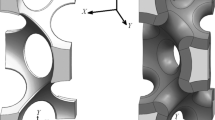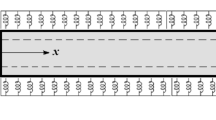Abstract
Materials whose Poisson’s ratio is negative (e.g., so-called auxetic materials) have a number of unusual mechanical and functional properties. This paper solves an orthotropic and elastic layer under a rigid cylinder indenter. The intensity factor of the stress field is adopted to characterize the concentration of the stresses at the edge of the indenter. Closed form solutions can be obtained if the diameter of the indenter is considerably small than the thickness of the elastic layer. Otherwise, the field intensity factors can be found numerically based on the dual integral equation technique. The effects of the layer thickness and Poisson’s ratio of the material on stress concentration at the indenter tip are discussed. The results show that materials with negative Poisson’s ratio can substantially reduce the stress concentration at the edge of the indenter and increase the energy absorbing. This research is helpful for understanding the possible failure behavior and to optimize the mechanical properties of the materials (i.e., Poisson’s ratio and elastic modulus) in order to achieve a maximum indentation resistance for auxetic materials.





Similar content being viewed by others
References
Lakes, R.: Foam structures with a negative Poisson’s ratio. Science 235, 1038–1040 (1987)
Evans, K.E., Nkansah, M.A., Hutchinson, I.J., Rogers, S.C.: Molecular network design. Nature 353, 124 (1991)
Elipe, J.C.A., Lantada, A.D.: Comparative study of auxetic geometries by means of computer-aided design and engineering. Smart Mater. Struct. 21, 105004 (2012)
Li, S., Hassanin, H., Attallah, H.M., Adkins, N.J., Essa, K.: The development of TiNi-based negative Poisson’s ratio structure using selective laser melting. Acta Mater. 105, 75–83 (2016)
Schwerdtfeger, J., Heinl, P., Singer, R.F., Körner, C.: Auxetic cellular structures through selective electron-beam melting. Phys. Status Solidi B. 247, 269–272 (2010)
Wang, K., Chang, Y.H., Chen, Y., Zhang, C., Wang, B.: Designable dual-material auxetic metamaterials using three-dimensional printing. Mater. Des. 67, 159–164 (2015)
Meena, K., Singamneni, S.: A new auxetic structure with significantly reduced stress concentration effects. Mater. Des. 173, 107779 (2019)
Cabras, L., Brun, M.: Auxetic two-dimensional lattices with Poisson’s ratio arbitrarily close to −1. Proc. R. Soc. A 470, 20140538 (2014)
Choi, J.B., Lakes, R.S.: Fracture toughness of re-entrant foam materials with a negative Poisson’s ratio: experiment and analysis. Int. J. Fract. 80, 73–83 (1996)
Lim, T.C.: Auxetic Materials and Structures, Springer Singapore Heidelberg New York Dordrecht London, 2015, ISSN 1612–1317
Bezazi, A., Scarpa, F.: Mechanical behaviour of conventional and negative Poisson’s ratio thermoplastic polyurethane foams under compressive cyclic loading. Int. J. Fatigue 29, 922–930 (2007)
Hu, J.S., Wang, B.L.: Enhanced fatigue performance of auxetic honeycomb/substrate structures under thermal cycling. Int. J. Mech. Sci. 199, 106432 (2021)
Lantada, A.D., Romero, Ad.B., Schwentenwein, M., Jellinek, C., Homa, J.: Lithography-based ceramic manufacture (LCM) of auxetic structures: present capabilities and challenges. Smart Mater. Struct. 25, 054015 (2016)
Hu, J.S., Wang, B.L., Li, J.E., Wang, K.F.: Thermal shock resistance behavior of auxetic ceramic honeycombs with a central crack or an edge crack. Ceram. Int. 46, 11835–21184 (2020)
Tan, X., Jo, W., Granzow, T., Frederick, J., Aulbach, E., Rödel, J.: Auxetic behavior under electrical loads in an induced ferroelectric phase. Appl. Phys. Lett. 94, 042909 (2009)
Tang, H., Jiang, X., Ling, L., Li, L., Hu, Y.: Highly tailorable electromechanical properties of auxetic piezoelectric ceramics with ultra-low porosity. J. Am. Ceram. Soc. 103, 6330–6347 (2020)
Tang, H., Jiang, X., Li, L., Ling, L., Hu, Y.: Electromechanical properties of ultra-low porous auxetic piezocomposite: from the perspective of Poisson’s ratio. J. Am. Ceram. Soc. 104, 2628–2645 (2021)
Miller, W., Smith, C.W., Scarpa, F.L., Abramovitch, H., Evans, K.E.: Multifunctional Negative Poisson’s ratio (Auxetic) Honeycomb Cores with Embedded Piezo-ceramic Patches, In Proceedings of ECCM-13, June 2–5, 2008, Stockholm, Sweden
Li, Z., Wang, K.F., Wang, B.L.: Indentation resistance of brittle auxetic structures: Combining discrete representation and continuum model. Eng. Fract. Mech. 252, 107824 (2021)
Hu, J.S., Wang, B.L.: Crack growth behavior and thermal shock resistance of ceramic sandwich structures with an auxetic honeycomb core. Compos. Struct. 260, 113256 (2021)
Li, J.E., Wang, B.L.: Effect of negative Poisson’s ratio on the fracture mechanics parameters due to mechanical and thermal loads. Int. J. Eng. Sci. 150, 103256 (2020)
Li, Z., Wang, B.L., Wang, K.F., Zheng, L.: Improving thermomechanical properties of cracked brittle honeycombs by negative Poisson’s ratio effect. Compos. Struct. 266, 113825 (2021)
Alderson, K.L., Pickles, A.P., Neale, P.J., Evans, K.E.: Auxetic polyethylene: the effect of a negative Poisson’s ratio on hardness. Acta Metall. Mater. 42, 2261–2266 (1994)
Evans, K.E., Alderson, A.: Auxetic materials: functional materials and structures from lateral thinking. Adv. Mater. 12, 617–628 (2000)
Evans, K.E., Alderson, A.: Auxetic materials: the positive side of being negative. Eng. Sci. Educ. J. 9, 148–154 (2000)
Scarpa, F., Ciffo, L.G., Yates, J.R.: Dynamic properties of high structural integrity auxetic open cell foam. Smart Mater. Struct. 13, 49 (2003)
Chan, N., Evans, K.E.: Indentation resilience of conventional and auxetic foams. J. Cell. Plast. 34, 231–260 (1998)
Webber, R.S., Alderson, K.L., Evans, K.E.: A novel fabrication route for auxetic polyethylene: Part 2 mechanical properties. Polym. Eng. Sci. 48, 1351–1358 (2008)
Lakes, R.S., Elms, K.: Indentability of conventional and negative Poisson’s ratio foams. J. Compos. Mater. 27, 1193–1202 (1993)
Li, Z., Wang, K.F., Wang, B.L., Guo, S.L.: The thermal shock resistance prediction of porous ceramic sandwich structures with temperature-dependent material properties. Ceram. Int. 45, 4043–4052 (2019)
Li, Z., Wang, B.L., Wang, K.F., Zheng, L.: A multi-scale model for predicting the thermal shock resistance of porous ceramics with temperature-dependent material properties. J. Eur. Ceram. Soc. 39, 2720–2730 (2019)
Hanuska, A., Novotny, B.: Circular punch on the unstretchable Westergaard-tyoe subgrade. Arch. Appl. Mech. 64, 127–135 (1994)
Comez, I., El-Borgi, S.: Contact problem of a graded layer supported by two rigid punches. Arch. Appl. Mech. 88, 1893–1903 (2018)
Comez, I., Omurtag, M.H.: Contact problem between a rigid punch and a functionally graded orthotropic layer resting on a Pasternak foundation. Arch. Appl. Mech. 91, 3937–3958 (2021)
Mahanty, M., Kumar, P., Singh, A.K., Chattopadhyay, A.: Analysis on the propagation of Griffith crack in a magnetoelastic self-reinforced strip subjected to moving punch of constant load. Arch. Appl. Mech. 91, 791–808 (2021)
Moula, M., Meille, S., Le Corre, V., Chevalier, J.: Mechanical characterization of meso-porous alumina by micro- and nano-indentation. Mater. Today Commun. 25, 101315 (2020)
Ben Ghorbal, G., Tricoteaux, A., Thuault, A., Ageorges, H., Roudet, F., Chicot, D.: Mechanical properties of thermally sprayed porous alumina coating by Vickers and Knoop indentation. Ceram. Int. 46, 19843–19851 (2020)
Liu, D.N., Ma, Z.C., Zhao, H.W., Ren, L.Q., Zhang, W.: Mechanical characterization of meso-porous alumina by micro- and nano-indentation. Mater. Today Commun. 28, 102659 (2021)
Choi, J.B., Lakes, R.S.: Analysis of elastic modulus of conventional foams and of re-entrant foam materials with a negative Poisson’s ratio. Int. J. Mech. Sci. 37, 51–59 (1995)
Harding, J.W., Sneddon, I.N.: The elastic stresses produced by the indentation of the plane surface of a semi-infinite elastic solid by a rigid punch. Proc. Camb. Philol. Soc. 41, 16 (1945)
Li, X.F.: T-stress near the tips of a cruciform crack with unequal arms. Eng. Fract. Mech. 73, 671–683 (2006)
Qiu, Y., Tian, Y., Sun, S., Hu, J., Wang, Y., Zhang, Z., Liu, A., Cheng, H., Gao, W., Zhang, W., Chai, H., Wu, H.: Bioinspired, multifunctional dual-mode pressure sensors as electronic skin for decoding complex loading processes and human motions. Nano Energy 78, 105337 (2000)
Wu, H., Li, L., Chai, G., Song, F., Kitamura, T.: Three-dimensional thermal weight function method for the interface crack problems in bimaterial structures under a transient thermal loading. J. Therm. Stresses 39, 371–385 (2016)
Li, Z., Wang, K.F., Wang, B.L., Li, J.E.: Size effect on the punch performance of brittle porous ceramics: theoretical analysis and numerical simulation. Int. J. Mech. Sci. 207, 106674 (2021)
Acknowledgements
This research was sponsored by Qing Lan Project of Jiangsu Province of China and the National Natural Science Foundation of China (project No. 11502101).
Author information
Authors and Affiliations
Corresponding authors
Ethics declarations
Conflict of interest
The authors do not have known competing financial interests or personal relationships that could have appeared to influence the work reported in this paper.
Additional information
Publisher's Note
Springer Nature remains neutral with regard to jurisdictional claims in published maps and institutional affiliations.
Appendix A
Appendix A
Displacements and stresses on the surface of the elastic layer.
Rights and permissions
About this article
Cite this article
Li, J., Wang, B. A porous layer of negative value of Poisson’s ratio under a flat-ended and rigid cylinder indenter. Arch Appl Mech 92, 1603–1614 (2022). https://doi.org/10.1007/s00419-022-02135-z
Received:
Accepted:
Published:
Issue Date:
DOI: https://doi.org/10.1007/s00419-022-02135-z




